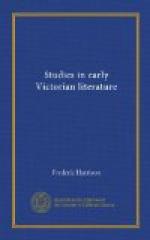And yet let us never forget that the Spanish Gypsy is a very grand conception, that it has some noble scenes, and here and there some stately lines—even some beautiful passages, could we forget the artificial alliteration and the tuneless discords to which the poet’s ear seems utterly insensible. The opening lines seem to promise well and have much of mellow thought, in spite of five hissing sibilants in the very first verse—
[Transcriber’s note: In the original book, the letters in the poem fragments under discussion were bolded. Here, they are delineated with slashes (/).]
’Ti/s/ the warm South, where
Europe spread/s/ her land/s/.
Like fretted leaflets, breathing on the
deep:
And then comes in the fourth line an awful cacophony of alliteration—and an alliteration in “c.”
A Calm earth-goddess crowned with corn and vines.
Then we have a really pretty but artificial line—an alliteration in “m.”
On the Mid Sea that moans with me/m/ories.
The seventh line again is an alliteration of alternate “p” and “d.”
Pant dumbly passionate with dreams of youth.
The tenth line is an excruciating alliteration in sibilants.
Feed/s/ the famed stream that water/s/ Andalu/s/.
But it must be admitted that the next line is graceful—
And loiters, amorous of the fragrant air.
The whole introduction of some 400 lines is full of beautiful images, fine thoughts, and striking phrases, but it is crowded, artificial, brocaded to excess with trop de choses; and it suddenly breaks into drama, with dialogue in person. This alternation of dramatic form and dialogue with epical narrative, interlarding the tragedy in parts with portentously long explanatory comment, is perhaps the most unlucky novelty which was ever attempted in verse. What would one say if even fine passages out of Wordsworth’s Excursion had been accidentally bound up between the pages of Shakespeare’s Hamlet?
But it is needless to enlarge on all the metrical and poetic defects of this medley of nearly 10,000 lines, with its lip-twisting, ear-torturing lyrics—(was there ever such a cacophony as—
O the sweet sweet prime
Of the past spring-time!)—
with its strange alternations of action and narration, its soliloquies of 150 unbroken lines, and all its other incongruities. The important point is, that it has a really grand scheme, that the characters of Zarca and of Fedalma are lofty, impressive, and nobly dramatic, that the whole poem is, in conception, a work of power and true imagination. Just as Kingsley, who had far greater poetic faculty than George Eliot, mistook in making the Saint’s Tragedy a drama, when he might have made it a grand historical romance, so George Eliot made a cruel mistake in writing the Spanish Gypsy as a poem, when she might have written it as an historical romance—a romance, it may be, much superior to Romola, as the subject and the conception were on grander lines.




